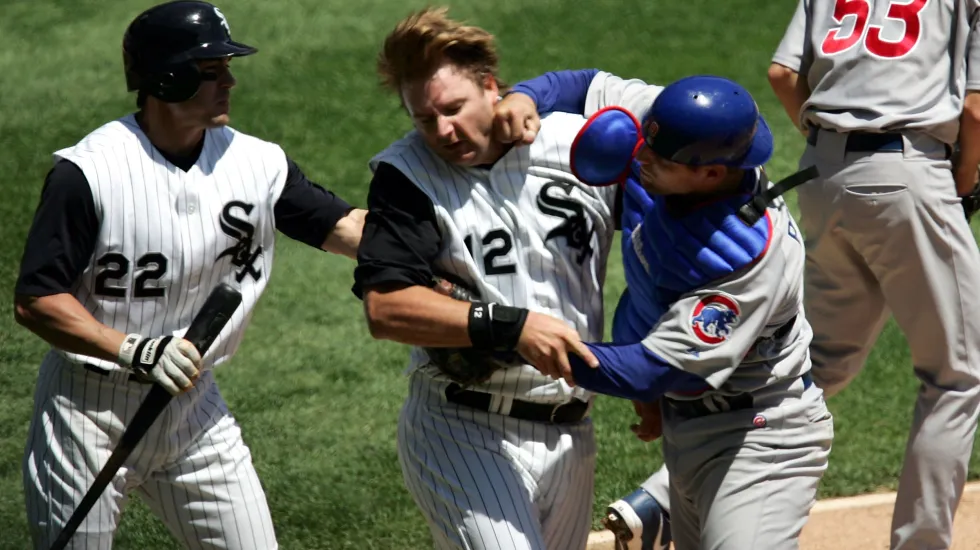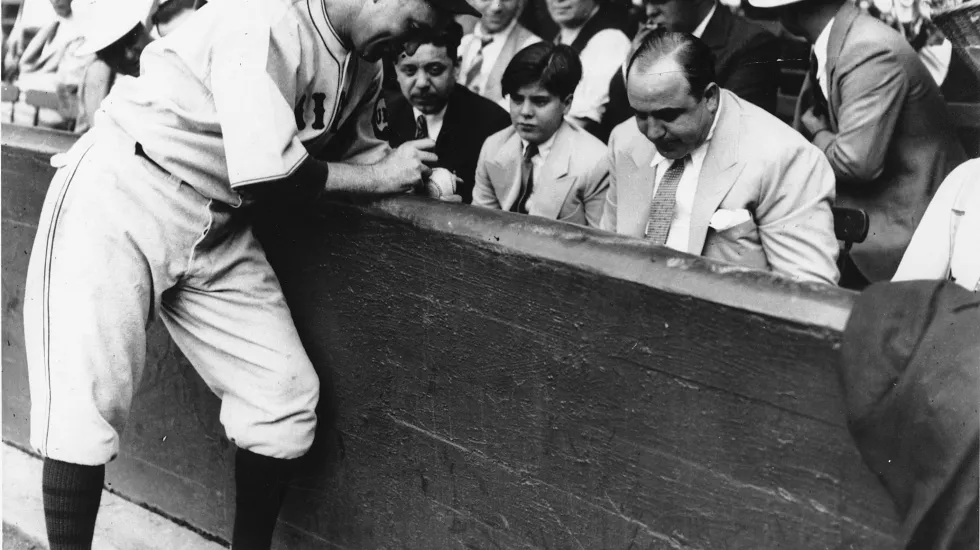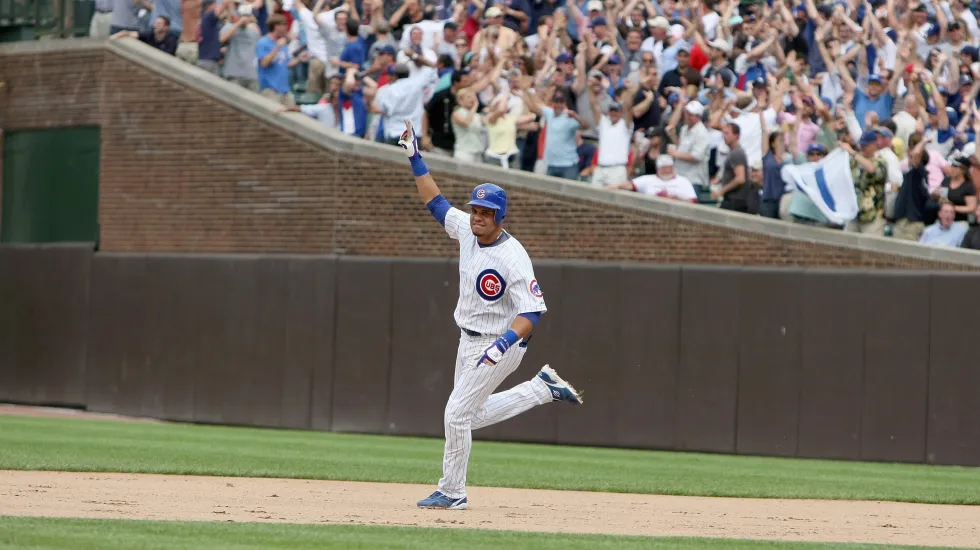
The legendary gangster was in the front row at Comiskey Park for an exhibition between Chicago’s baseball teams in 1931, just a few months before he was convicted on income-tax-evasion charges and sent to prison. Captured in an iconic photo from that day is Cubs catcher Gabby Hartnett signing a ball for Capone’s son as the bad man looks on and bodyguards in white hats sit a row behind. More than 80 years later, one can get lost studying their faces.

So there’s that. Most images chronicling the North-South rivalry’s history aren’t quite as deliciously evocative.
But there has been no shortage of unforgettable stuff since (anybody remember it firsthand?) the Sox beat the Cubs in the 1906 World Series, still the only one of its crosstown-Chicago kind. Maybe, just maybe, there will be another Fall Classic between the teams — Red Line magic — someday. Short of that, we can revel in memories of regular-season moments and outcomes that have counted since interleague play took hold in 1997.
There was Sox slugger Carlos Lee’s walk-off grand slam — the first one in interleague play across the big leagues — off Courtney Duncan at Comiskey in 2001.
“El Caballo!” Ken “Hawk” Harrelson roared into the night.
There was Sox first baseman Paul Konerko homering twice — after being hit by a pitch — as the Sox rallied from an 8-0 deficit to win at home a year later.
And Cubs third baseman Aramis Ramirez belting a leadoff homer off Scott Linebrink in the ninth at Wrigley midway through the 2008 campaign, with both playoff-bound teams in first place.

“Ballgame over!” Len Kasper shouted. “Cubs win!”
Don’t forget then-Sox manager Ozzie Guillen kicking Cubs catcher Geovany Soto’s mask after being ejected in 2011. Fortunately for all involved, Soto wasn’t wearing the mask at the time. And who could forget Cubs catcher Willson Contreras’ sky-high bat flip in 2020? Up, up, up . . . did that really happen?
There have been light moments, such as one hilariously bad Chevy commercial after another in which Guillen and former Cubs skipper Lou Piniella — friendly foes — starred together. And heavy moments, too, such as Harrelson’s tearful 2018 goodbye, ending 33 seasons as a Sox broadcaster, after a game against the Cubs at Guaranteed Rate Field.
“And this ballgame is ovah,” he said.
“Very much, I have enjoyed it. I’ve loved it. And I will never forget it.”
But we can go back further than the beginning of the interleague-play era. Much further.
Through most of the first half of the 20th century, the teams played a yearly City Series against each other. And these weren’t just one-off exhibitions; many of the series, held after the season, were best-of-seven or even longer than that.
Post-World War II, the teams played an annual Boys Benefit game, a midsummer exhibition to raise money for the Chicago Park District’s baseball programs. This lasted until 1972, with the city’s baseball fans always turning out in big numbers.
The in-season exhibitions from 1985 to ’95 weren’t exactly big deals — especially, it seemed, to the Cubs, who somehow managed never to win one. It’s sad but true: They went 0-10-2.
“It seems like the Cubs were always trailing,” Andre Dawson says now. “For us, it was like a spring-training game. Play a few innings, shower up, go home.”
Well, no wonder.
“We took it more serious than the Cubs did,” Guillen says. “Why? Because Tony La Russa demands to go out there and play it right. Even after he was fired [in 1986], it was still his team because he raised us. No matter who we [played] against, it was all about winning.”
One time, in 1994, the Sox even employed a secret weapon: a little-known right fielder by the name of Michael Jeffrey Jordan. With a pair of run-scoring hits — off Dave Otto and Chuck Crim, bless ’em both — Jordan carried the Sox back into what ended as a 4-4 tie at Wrigley. Who says winning NBA Finals MVP is a bigger deal than making the Budweiser Play of the Game?
The pregame interview on the field between giants Jordan and Harry Caray is one of the forgotten gems of the long Cubs-Sox story.
“I want you to know,” Caray said, “I’ve been around this game for 50 years, and this is the biggest thrill of my life, just seeing you in a baseball uniform.”
Answered Jordan: “If I ever develop the skills to be [in the majors], then great. If I don’t, at last I fulfilled a dream of at least trying.”
But once the games got real in 1997, the rivalry really began to flower. It took hardly any time. Whatever it was officially called, it was us vs. you, North vs. South, Addison Street vs. 35th Street, blue vs. black, good vs. bad, bad vs. good. It became a huge deal, often as close as Chicago baseball got to something resembling playoff baseball.
“Cubs-White Sox games are very special,” longtime Cubs radio man Pat Hughes says. “Just the feeling in the ballpark, no matter what side of town, it’s a very special atmosphere.”
Guillen takes it a step further. Then again, doesn’t he always?
“I don’t know about now — maybe it [has gotten] a little less important to the players — but for a lot of years it was amazing,’’ he says. ‘‘I mean, so important for the White Sox and Cubs fans. To me, it’s the closest thing you can be to being in the World Series. It’s that intense. The fans are into it, the media’s into it, all the town is into it. I [bleeping] love it.”
Capone would have loved it, too. We’d tell you how we know that, but then we’d have to . . . you know what? Never mind.
Since the start of interleague play, the Sox have a 70-64 edge — 35-32 on each side of town — over the Cubs. Hmm, that’s pretty close. It certainly doesn’t seem very conclusive. Guess the teams will just have to keep hooking up on the field — four times in 2022, Lord willing — and see how this thing plays out.







